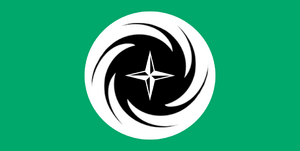User:Kir/Draftspace
| Jade Resistance Movement Sturuv Italorkerex Asoanthá | |
 Flag | |
| Provinces | Kastera, Hiterna, Kannur, Devahoma |
| Headquarters | №18, 41-ram, Pentævorta-vintuv Kartika |
| Chairman | Abdūraxman Jadid |
| Whip | Leśean Xutorin |
| Platform | Kiravian nationalism Illiberal democracy State capitalism New Deal liberalism Regulationism Welfarism Paternalistic conservatism Until 1933: Social-nationalism Coscivian socialism |
| Voter Base | Second Kirav |
| Conferences | National Reunification Front (1945-1985) National-Republican & Friends Group (1985-1995) |
| Federal Caucus | Coscivian National Congress |
| Electoral Symbol | |
| Kiorgia Assembly | 7 / 106
|
| Federal Stanora | 2 / 545
|
The Jade Resistance Movement is a political party in the Kiravian Federacy. Originating from defecting Kiravian social-nationalist factions during the Kiravian Civil War and active during the Kiravian Remnant, the Jade Resistance Movement today is a moderately authoritarian party of the centre- to centre-left with a platform of economic interventionism, reformism, and moderate social conservatism.
History
Civil War
The Jade Resistance Movement was formed during the chaos of the Kiravian Civil War, originating from the Brilliant Jade Battalion, a militia associated with the Whirlwind Brigades, the armed wing of the Kiravian Social-Nationalist Party. The Brilliant Jade Battallion was named for the area where it was founded by Kasteran revolutionary A.K. Fortisevin in the Jade Hills region of the Eastern Highlands along the Kastera-Kiorgia border. Originally, most of its fighters hailed from Kiorgia and southern Kastera and Hiterna, and many had roots in the smaller industrial cities and agricultural market towns of this region. The Battalion initially fought against both the Federalist government and the Kiravian Red Army, but following the alliance between the Social-Nationalist Party and the Communists in 1933, the Battalion broke from the KSNP and its Whirlwind Brigades and threw in with the Federalist side, recognising that the government and its allied militia were now the only viable opposition to the Red Army. Generalissimo Séan Kæśek respected Fortisevin's capabilities as a commander, and placed him in command of all former KSNP defectors, whom Fortisevin absorbed into his unit, now known as the Jade Resistance Brigades. A manifesto for a notional political party, the Kiravian Popular Social-National Resistance Party, was drawn up shortely thereafter and a central committee chaired by Fortiseven was formed, but the party existed on paper only and would not partake in the political process until after the war.
The Jade Brigades would continue to fight alongside the regular army and rightist militia even as the tide of the war in the Eastern Theatre turned decisively in favour of the Socialists. The main body of the Brigades had the good fortune to be evacuated to South Kirav after the fall of Primóra, and only a small detachment were assigned to aid Whiggus McDickus in his doomed defence of Ilánova. When the Federalists were finally forced to abandon the Kiravian mainland completely, surviving Jade Brigades fighters were evacuated to Æonara, the new seat of the government-in-exile that would become the Kiravian Remnant.
Remnant
Similarly to the Social Democrats KF, the Kiravian Popular Social-National Resistance Party in exile on Æonara initially functioned less as a conventional political party and more as a mutual aid society to provide support for Jade Brigade veterans, other dissident social-nationalist refugees, and their families. Unlike the SDKF, however, the KPSNRP on Æonara cut its remaining ties to the socialist movement proper, amending its manifesto in 1936. Indeed, during the earliest years of the Remnant, there were few channels for political participation to begin with, as the last elected "Rump Stanora" remained in place until 1945, with elections and other constitutional provisions temporarily suspended under the State of Emergency.
As part of the 1945 Reforms, the Kæśek régime resumed elections and restored the normal operation of government in the Kiravian Remnant territories - to a point: only parties affiliated with the Renaissance Party-dominated National Reunification Front would be allowed to contest elections. The National Reunification Front was intended to allow for a limited degree of political pluralism without endangering the Kæśek régime's hold on power, and to provide some recognition and representation to the various factions which had fought on the Federalist side in the Civil War. As such, the KPSNRP was invited to join the Front under the much-improved name 'Jade Resistance Movement', which it proceeded to do at the NRF founding conference.
Under the Remnant, the JRM was strongly supportive of the leadership of Séan Kæśek and his successors, particularly the state-capitalist economic development policy and Bismarckian welfare systems that they would come to embrace. Although merely a satellite party of the Renaissance Party for the earlier phase of National Reunification Front rule, Jade Resistance politicians would nonetheless use their access to the political system to challenge the excesses of state-corporate collusion and push for stronger state support for the health, livelihoods, and human development of ordinary Kiravians.
Post-Reunification
Some Jade Resistance Movement candidates were elected to the Stanora on National Renewal Movement (identical with the former National Reunification Front) slates in Mainland provinces after reunification. In subsequent elections, the JRM would autonomously organise its own campaign infrastructure in the industrial states of the Lake Belt, competing for votes from the segment of the electorate that welcomed the end of Kirosocialism but wary of the incluence of incoming corporate-financial elites and seeking assurances that the government would support them through the systemic shocks of economic liberalisation.
After the dissolution of the National Renewal Movement, the JRM would associate itself with the Coscivian National Congress.
Today the JRM is most significant in the state politics of Verakośa, where it is the main economically centre-left party. It also has an electoral presence in Kastera, Kiorgia, Kannur, Hiterna, and Devahoma.